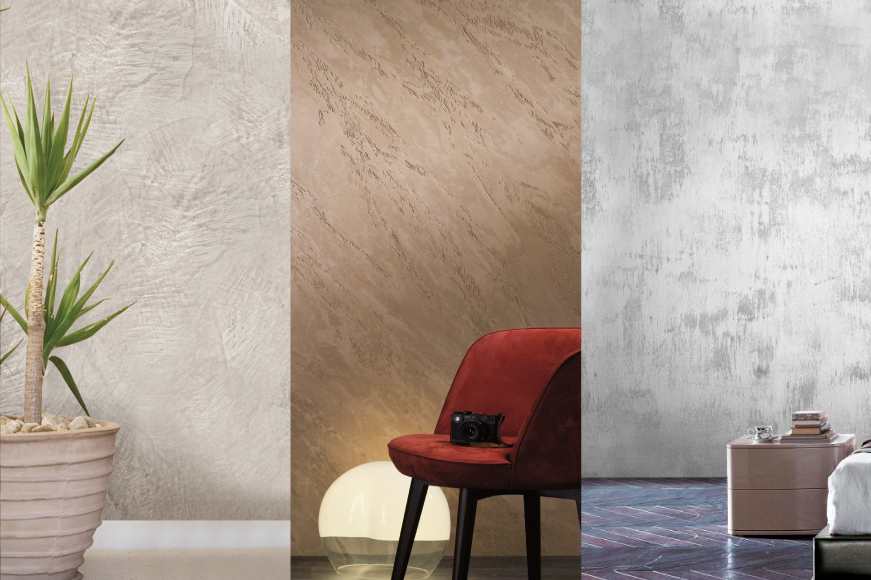
In our articles, we often note the importance of coziness in the house, which is primarily due to visual parameters, such as surface cladding - floor, ceiling, walls. It should be remembered that cladding is important not only for creating beauty, but also for protecting surfaces, which in fact are load-bearing structures that perform certain physical functions.
In this article, we will consider such a type of facing materials as decorative plaster, it’s composition, properties and scope.
What is included in decorative plaster?
The uniqueness and difference of decorative plaster from the usual leveling mixture lies in it’s composition - the presence of plasticizers, polymer binders and structure-forming additives, such as granite and marble chips, stone dust, pearlescent glitters and other fillers. These components affect the performance characteristics of plasters - moisture resistance, vapor permeability, fire resistance, sound insulation, thermal insulation, no mold, etc.
What types of decorative plaster are on the market?
Mineral decorative plaster. Convenient ratio of price and quality. Consists of cement and lime. Presented as a dry mix. Can be used after dilution with water. It can also include a marble crumb and the larger it’s granules, the more relief the processed surface will be. Water-repellent components make it possible to apply mineral plaster both to the interior walls of the premises and to the facade of the building, as well as in bathrooms. The advantages also include fire resistance, vapor permeability, i.e. the possibility of air circulation, and in addition, mineral plaster is resistant to physical damage. It is also worth noting that mineral plaster is inelastic, so it should not be used in places where there is a high level of vibration.
Acrylic (polymer) plaster. Ready water-dispersion mixture. It contains a filler (glass chips, marble, ash waste, etc.) and a polymer binder. Coloring will make it possible to choose the desired color. Of course, acrylic plaster is resistant to the effects of liquids, but we do not recommend removing the facades of buildings with it, since the low level of vapor permeability excludes the possibility of air circulation. This can lead to the appearance of fungi, mold and deterioration of the quality of the walls, especially if you make thermal insulation with cotton wool.
Types of decorative plaster.
Venetian plaster. For the first time, Venetian plaster began to be used in ancient Rome, when after the walls were tiled with marble, a lot of marble dust remained. Now, in addition to slaked lime, an aqueous emulsion is also added to the technology of it’s production. It is possible to apply Venetian plaster only on perfectly flat walls, which will help create a marble effect. Among the advantages of decorative plaster, such parameters as water resistance, environmental friendliness, wear resistance, fire safety, and lack of smell are significant.
Structural plaster is a heterogeneous granular mass to which various granules are added: chunks of alum, stone chips, wood fiber, etc. Structural plaster is made on the basis of synthetic latices or potassium silicate, water base or on solvents. For finishing the walls inside the premises, only plaster on a water base is used, since it does not have an odor and is safe for people. The granules themselves at the factory can be painted in different colors and shades. To achieve the correct wall finish, the master must level the surface with a trowel, focusing on the thickness of the grain. After that, a drawing is applied with a grater, under which the larger granules roll, leaving a trace.
The decorative plaster "bark beetle" got it’s name because of the structure that resembles the surface of a tree, eaten by the larvae of the bark beetle. It looks pretty impressive and beautiful. It contains two types of fillers - small and large (granules presented in the form of small, rounded pebbles). The bark beetle is used for finishing the facades of buildings. It is applied simply and does not require special skills or knowledge, as well as specific tools.
Textured plaster is the most popular plaster on the market. It allows you to create relief surfaces or various patterns from available tools. To do this, you just need to apply one continuous layer of plaster, and then form a pattern. If you do not have special relief rollers, then you can use plastic wrap or a crumpled piece of foil, paper, etc. After that, chaotic stains remain on the surface, creating a relief effect.
At the end of the article, we want to say that on our site you will find not only a rich variety of decorative plasters, but tools for their application.
“Domino” wishes you all of best!
